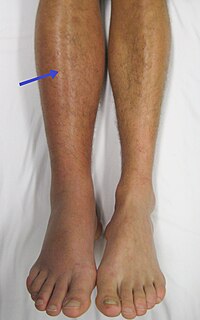
Photo from wikipedia
Objective: Research is needed to guide the timing and safety of rehabilitation (physical and occupational therapy) in patients with acute deep venous thrombosis (DVT) that is untreated due to contraindications.… Click to show full abstract
Objective: Research is needed to guide the timing and safety of rehabilitation (physical and occupational therapy) in patients with acute deep venous thrombosis (DVT) that is untreated due to contraindications. Case Description: A 21-year-old man with Hodgkin lymphoma was admitted to the hospital for neutropenic fever. He developed gastrointestinal bleeding, diffuse alveolar hemorrhage, and bilateral lower-extremity DVT. He was not a candidate for chemical anticoagulation or placement of an inferior vena cava filter owing to thrombocytopenia. Rehabilitation was initially deferred because of concern that the thrombus could travel to the lungs, causing a pulmonary embolism. Rehabilitation was, however, started 4 days after the initial diagnosis of lower-extremity DVT to assess functional mobility and activities of daily living skills to prepare for discharge from the hospital. Results: The patient experienced no bleeding events during rehabilitation, and his acute, untreated DVT did not propagate based on clinical assessment. His Activity Measure for Post-Acute Care (AM-PAC) “6 Clicks” Basic Mobility score improved from 30.25 to 35.55 over the period of 11 days while he received rehabilitation. Conclusion: Despite having an acute bilateral lower-extremity DVT that was untreatable owing to thrombocytopenia, the patient successfully participated in rehabilitation and improved his physical functional status without an adverse event. Untreated acute venous thromboembolism in the setting of recent history of major bleeding raise concerns about physical activity restrictions. It is critical to consider both the risks and benefits of mobilizing patients and prescribing exercises in patients with these conditions.
Journal Title: Integrative Cancer Therapies
Year Published: 2022
Link to full text (if available)
Share on Social Media: Sign Up to like & get
recommendations!